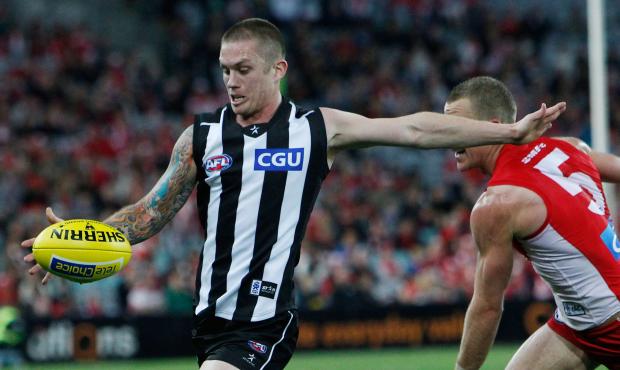The Magpies have gone from the team that played on the most after a mark in rounds 17 and 18 to a team that has stopped and propped before hitting the target in the past two rounds.
In wins over Essendon and the Sydney Swans, Collingwood has played on after a mark just 23.8 per cent of the time on average. Only Gold Coast has done so less.
As a result – or perhaps by coincidence – that methodical approach has seen the Pies lead the competition for effective kicks in the past two rounds, with an average of 161.5 per game.
In the two less-than-impressive performances against Gold Coast and the Giants before that, Collingwood averaged just 141 effective kicks per game and led the competition in clanger kicks.
The biggest shift in the wins against the Bombers and Swans occurred in the midfield, with the Magpies playing on after a mark in that region just 25.8 per cent of the time (ranked 17th).
In the previous 18 rounds, they played on after a mark in the midfield 37.5 per cent of the time.
A less dramatic drop has occurred in defence with the team playing on after a mark 31 per cent of the time (11th) compared to 36.9 per cent (fourth) in the previous 18 rounds.
It is playing the game at its own tempo, like a rock band unplugged.
Get the footy, assess the options and make sure the dots can be joined - or hold up the play for enough time to gather some composure and then surge.
Those surges often result in goals, with most of Collingwood's goals on Saturday night coming from relentless ball movement.
But it is getting better at knowing when to go, and when to slow.
As a result, Collingwood has averaged four more inside-50s and three more marks in the forward 50 in the past fortnight than in the two weeks prior.
It has benefited from having two key targets up forward, with Travis Cloke and Ben Reid strong marking options.
Cloke has benefited from Reid getting dangerous up forward because it reduces the ability of multiple defenders to head in his direction.
Jamie Elliott is a good support act although he has been inconsistent recently. The Magpies have also pushed Dane Swan and Dayne Beams forward at various times to create some dynamic marking options.
But slowing down the game from midfield has allowed forwards to push forward and double back, putting pressure on defenders.

The return of Beams has helped too.
His performance has been remarkable since returning to the team in round 16 against Adelaide.
After that one game warm-up, he has got purring.
In the past month Beams has led the AFL for inside-50s with 23 and is equal first for loose-ball gets. That he is ranked fourth for score involvements, fifth for disposals and contested possessions shows his all-round class given he missed the first 15 rounds.
That is a credit both to Beams and the conditioning process he underwent to ensure he finally resumed ready.
He's become a player to watch, his economy of movement and ability to sweep around chaotic congestion like watching a classy kayaker glide down a raging river.
Luke Ball was back to his best against the Swans, hitting stoppages at pace while Scott Pendlebury and Swan maintained their high standards.
Ball, Beams, Pendlebury and Swan have played together just six times under Nathan Buckley.
Slowly, things are coming together at the Magpies.
They have used the same 22 two weeks in succession and the teams has eight difference faces when compared to the side that took on Hawthorn in round three.
Now Hawthorn awaits again, a team that has beaten Collingwood in its four encounters since Buckley took over.
"We feel that we are just starting to settle," Buckley said after beating the Swans.
For many, the next contest can't come quickly enough.
Stats supplied by Champion Data


